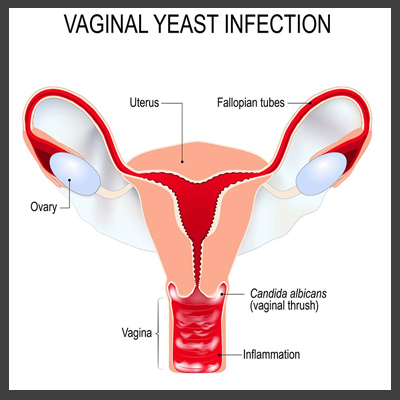

A vaginal yeast infection is a fungal infection that causes irritation, discharge and intense itchiness of the vagina and the vulva the tissues at the vaginal opening. Also called vaginal candidiasis, vaginal yeast infection affects up to 3 out of 4 women at some point in their lifetimes. Many women experience at least two episodes. A vaginal yeast infection is not considered a sexually transmitted infection. But, there is an increased risk of vaginal yeast infection at the time of first regular sexual activity. There is also some evidence that infections may be linked to mouth to genital contact (oral-genital sex).
Medications can effectively treat vaginal yeast infections. If one have recurrent yeast infections four or more within a year one may need a longer treatment course and a maintenance plan.
Yeast infection symptoms can range from mild to moderate, and include:
One might have a complicated yeast infection if:
The fungus candida albicans is responsible for most vaginal yeast infections.
Your vagina naturally contains a balanced mix of yeast, including candida, and bacteria. Certain bacteria (lactobacillus) act to prevent an overgrowth of yeast.
But that balance can be disrupted. An overgrowth of candida or penetration of the fungus into deeper vaginal cell layers causes the signs and symptoms of a yeast infection.
Overgrowth of yeast can result from:
Candida albicans is the most common type of fungus to cause yeast infections. Yeast infections caused by other types of candida fungus can be more difficult to treat, and generally need more-aggressive therapies.
Factors that increase one risk of developing a yeast infection include:
To reduce risk of vaginal yeast infections, wear underwear that has a cotton crotch and doesn't fit too tightly.
It might also help to avoid:
CALCAREA CARB
Indicated for vaginal yeast infection when there is burning and itching feelings may occur both before and after the menstrual period.There is discharge from vaginitis which is milky and acrid or thick and yellow. Recommended for a person who is often chilly and stout, has a craving for sweets, and is easily tired by exertion.
KREOSOTE
Strongly indicated for vaginitis with watery, thin, unpleasant-smelling, very irritating discharge that makes the vulva swell and itch which may be worse in the morning and worse when standing up.Useful for infections which are more likely to appear before the menstrual period or during pregnancy.
NATRUM MUR
Useful for Vaginitis with discharge resembling egg-white, which itches and makes the vagina feel dry and irritated, is likely to respond to this remedy. Suited to woman who often seems reserved, yet is very emotional inside. There is craving for salt and a tendency to feel worse from being in the sun
SEPIA
Useful for yeast infections which cause vaginal discharge that is yellow and itchy, or white and curdlike.Given when women often feels worn down and irritable, with cold extremities and and a weak or sagging feeling in the pelvic region.There is discharge may be more profuse in the morning and increased by walking.
BORAX
Useful for Yeast infections of the vagina with discharge resembling egg white, and a feeling that warm water is flowing out. Useful for vaginitis which appears midway between the menstrual periods. Recommended when person who is often nervous and very sensitive to noise.
KALI BICHROME
Indicated in cases of vaginitis where discharge is yellow and tenacious, and makes the vulva itch and burn which may be worse in the morning.Given when person feels better from resting and keeping warm.
PULSATILLA
Indicated for yeast infections where symptoms may be changeable.There is creamy white or yellowish discharge appears, which can be either bland or irritating. Given when the vagina may feel sore, and the labia may itch or burn. Suited to woman who will be moody, possibly tearful, wanting a lot of attention and affection.Helpful for vaginitis during pregnancy.
SULPHUR
Useful for discharge that looks yellowish, is offensive-smelling, and causes great burning and itching brings this remedy to mind. Symptoms may be aggravated by warmth and bathing.e.t.c